Industrial Engineering: Corrosion, Electrolytes, and Anodizing
VerifiedAdded on 2023/04/10
|10
|1129
|318
Homework Assignment
AI Summary
This industrial engineering assignment delves into the complexities of corrosion, examining variation in corrosion rates related to surface wetting and drying, as well as oxygen consumption and metal loss. It analyzes the aggressiveness of different aqueous electrolytes to pitting corrosion, ranking them from least to most corrosive. The assignment further explains the role of second phase inclusions in the localized corrosion of aluminum alloys, specifically Al-Fe, Al-Cu, and Al-Mg alloys. Finally, it calculates the volume of a coated layer during aluminum anodizing and discusses the processes occurring on the aluminum surface during this process. The document also includes calculations for partial pressures of Helium, Argon and Carbon Monoxide in a mixture. Desklib offers a platform to access this and other solved assignments for students.
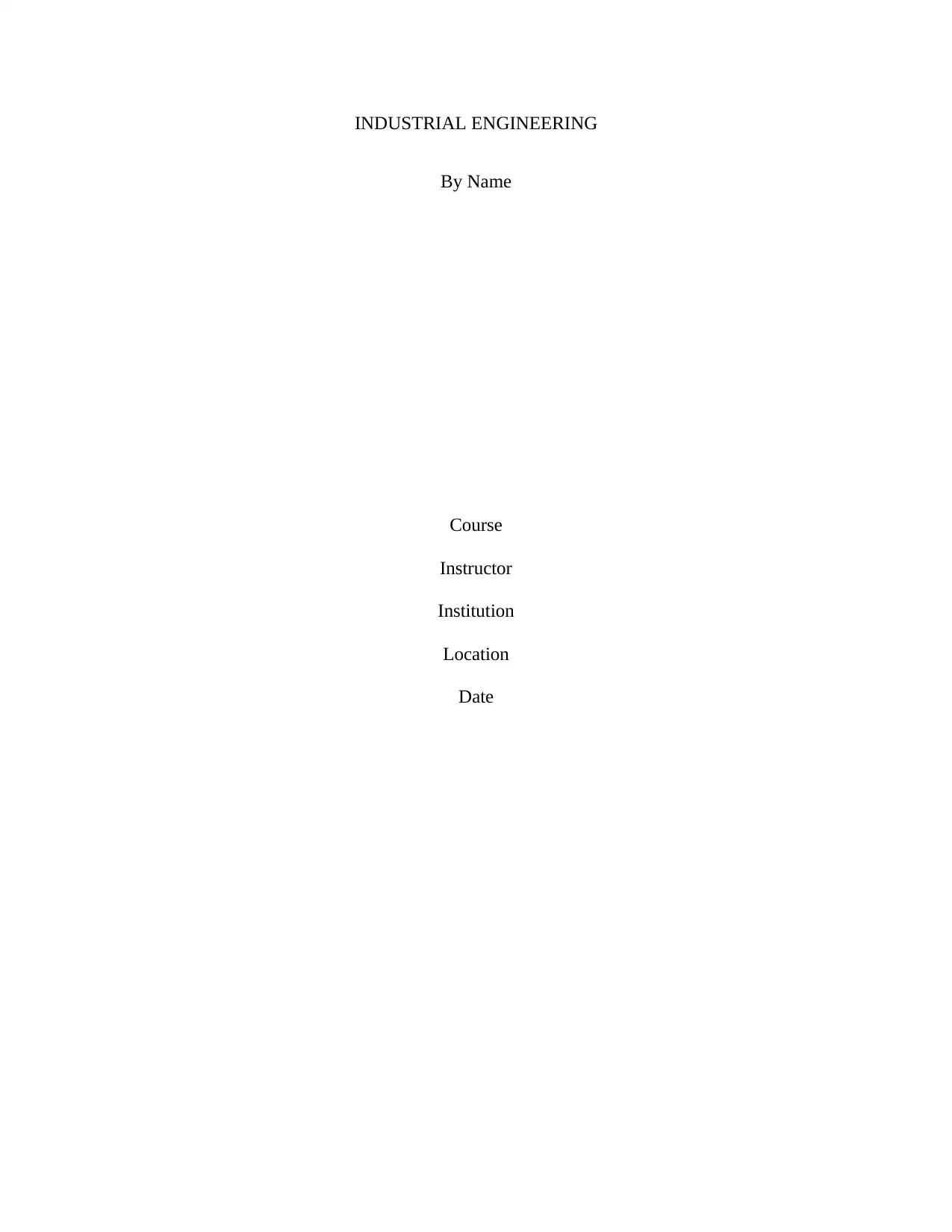
INDUSTRIAL ENGINEERING
By Name
Course
Instructor
Institution
Location
Date
By Name
Course
Instructor
Institution
Location
Date
Paraphrase This Document
Need a fresh take? Get an instant paraphrase of this document with our AI Paraphraser
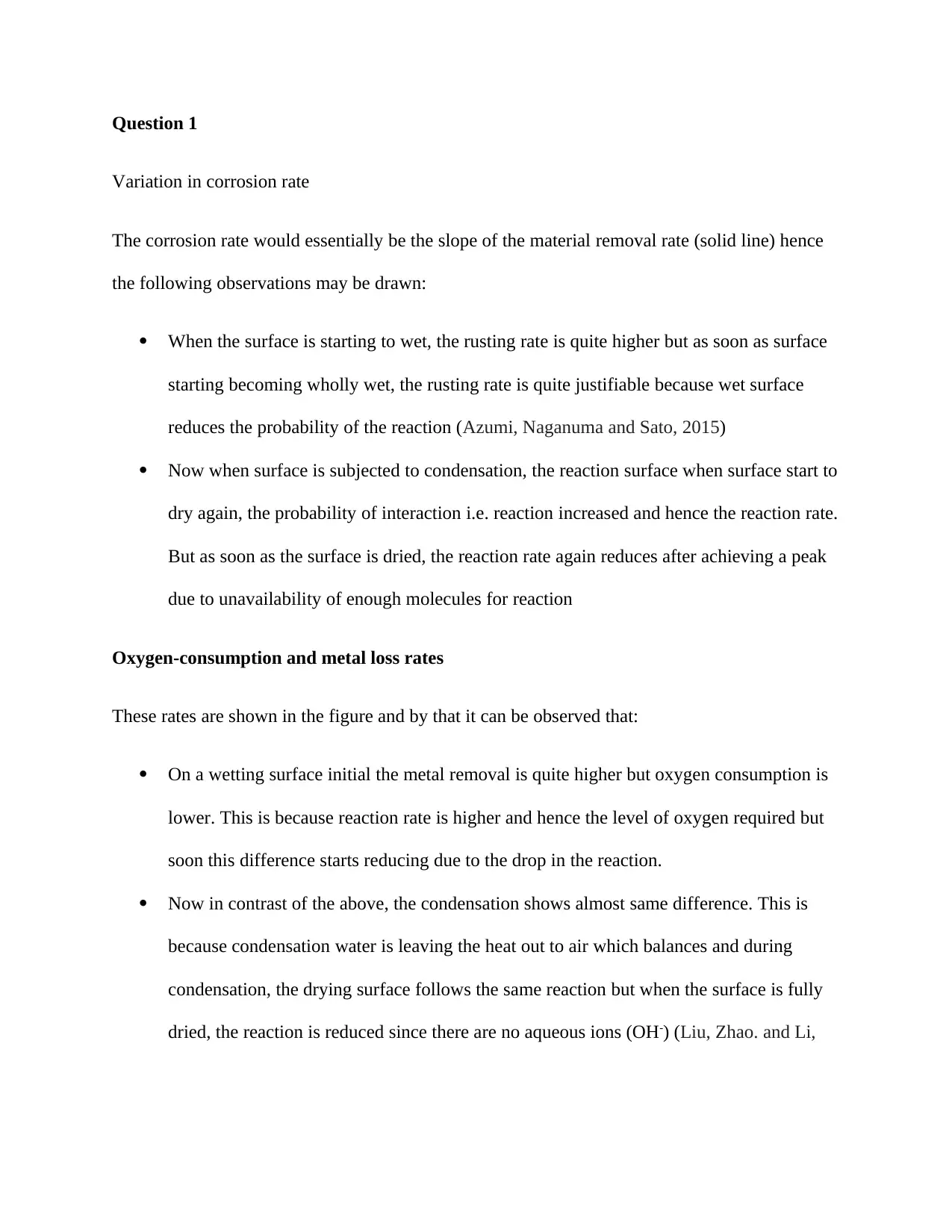
Question 1
Variation in corrosion rate
The corrosion rate would essentially be the slope of the material removal rate (solid line) hence
the following observations may be drawn:
When the surface is starting to wet, the rusting rate is quite higher but as soon as surface
starting becoming wholly wet, the rusting rate is quite justifiable because wet surface
reduces the probability of the reaction (Azumi, Naganuma and Sato, 2015)
Now when surface is subjected to condensation, the reaction surface when surface start to
dry again, the probability of interaction i.e. reaction increased and hence the reaction rate.
But as soon as the surface is dried, the reaction rate again reduces after achieving a peak
due to unavailability of enough molecules for reaction
Oxygen-consumption and metal loss rates
These rates are shown in the figure and by that it can be observed that:
On a wetting surface initial the metal removal is quite higher but oxygen consumption is
lower. This is because reaction rate is higher and hence the level of oxygen required but
soon this difference starts reducing due to the drop in the reaction.
Now in contrast of the above, the condensation shows almost same difference. This is
because condensation water is leaving the heat out to air which balances and during
condensation, the drying surface follows the same reaction but when the surface is fully
dried, the reaction is reduced since there are no aqueous ions (OH-) (Liu, Zhao. and Li,
Variation in corrosion rate
The corrosion rate would essentially be the slope of the material removal rate (solid line) hence
the following observations may be drawn:
When the surface is starting to wet, the rusting rate is quite higher but as soon as surface
starting becoming wholly wet, the rusting rate is quite justifiable because wet surface
reduces the probability of the reaction (Azumi, Naganuma and Sato, 2015)
Now when surface is subjected to condensation, the reaction surface when surface start to
dry again, the probability of interaction i.e. reaction increased and hence the reaction rate.
But as soon as the surface is dried, the reaction rate again reduces after achieving a peak
due to unavailability of enough molecules for reaction
Oxygen-consumption and metal loss rates
These rates are shown in the figure and by that it can be observed that:
On a wetting surface initial the metal removal is quite higher but oxygen consumption is
lower. This is because reaction rate is higher and hence the level of oxygen required but
soon this difference starts reducing due to the drop in the reaction.
Now in contrast of the above, the condensation shows almost same difference. This is
because condensation water is leaving the heat out to air which balances and during
condensation, the drying surface follows the same reaction but when the surface is fully
dried, the reaction is reduced since there are no aqueous ions (OH-) (Liu, Zhao. and Li,
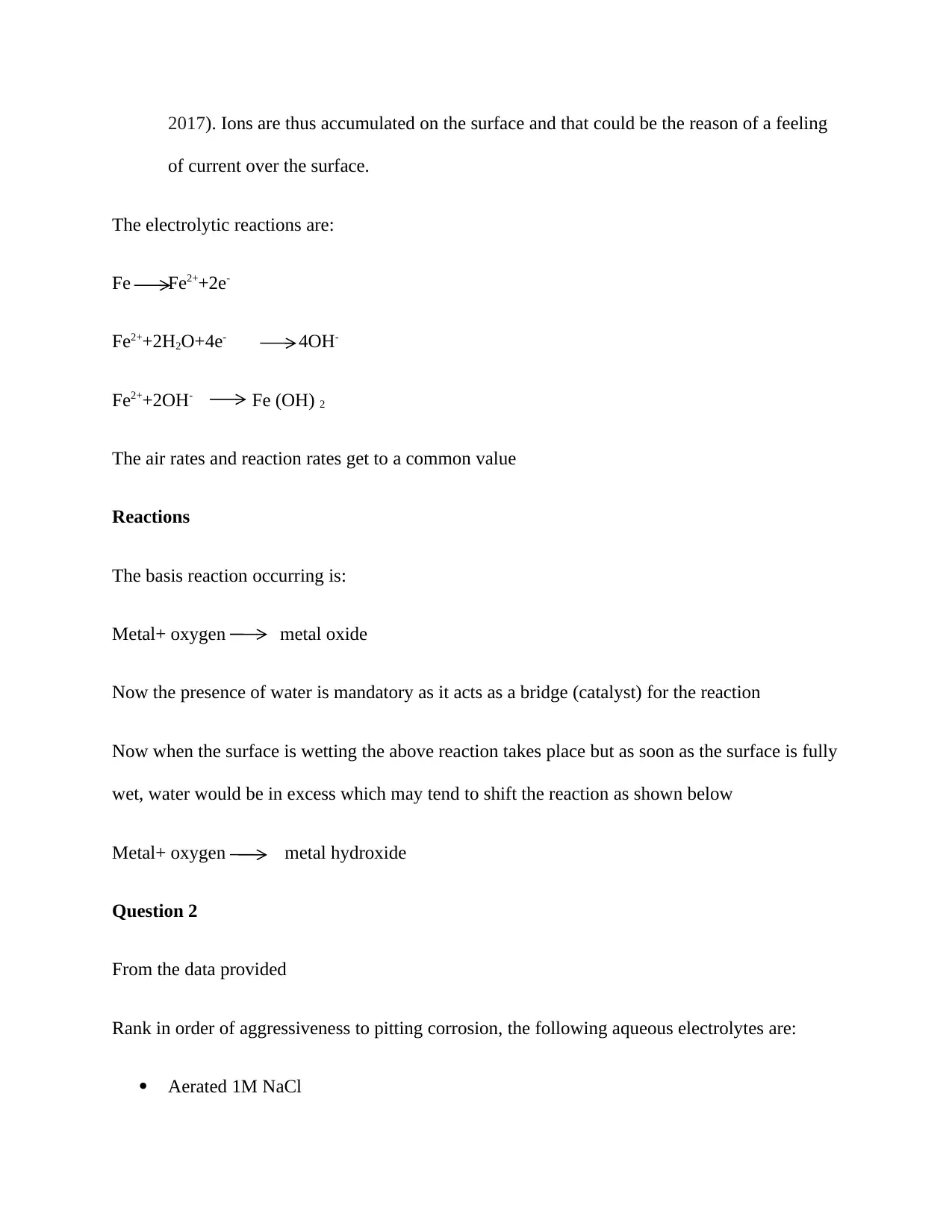
2017). Ions are thus accumulated on the surface and that could be the reason of a feeling
of current over the surface.
The electrolytic reactions are:
Fe Fe2++2e-
Fe2++2H2O+4e- 4OH-
Fe2++2OH- Fe (OH) 2
The air rates and reaction rates get to a common value
Reactions
The basis reaction occurring is:
Metal+ oxygen metal oxide
Now the presence of water is mandatory as it acts as a bridge (catalyst) for the reaction
Now when the surface is wetting the above reaction takes place but as soon as the surface is fully
wet, water would be in excess which may tend to shift the reaction as shown below
Metal+ oxygen metal hydroxide
Question 2
From the data provided
Rank in order of aggressiveness to pitting corrosion, the following aqueous electrolytes are:
Aerated 1M NaCl
of current over the surface.
The electrolytic reactions are:
Fe Fe2++2e-
Fe2++2H2O+4e- 4OH-
Fe2++2OH- Fe (OH) 2
The air rates and reaction rates get to a common value
Reactions
The basis reaction occurring is:
Metal+ oxygen metal oxide
Now the presence of water is mandatory as it acts as a bridge (catalyst) for the reaction
Now when the surface is wetting the above reaction takes place but as soon as the surface is fully
wet, water would be in excess which may tend to shift the reaction as shown below
Metal+ oxygen metal hydroxide
Question 2
From the data provided
Rank in order of aggressiveness to pitting corrosion, the following aqueous electrolytes are:
Aerated 1M NaCl
⊘ This is a preview!⊘
Do you want full access?
Subscribe today to unlock all pages.

Trusted by 1+ million students worldwide
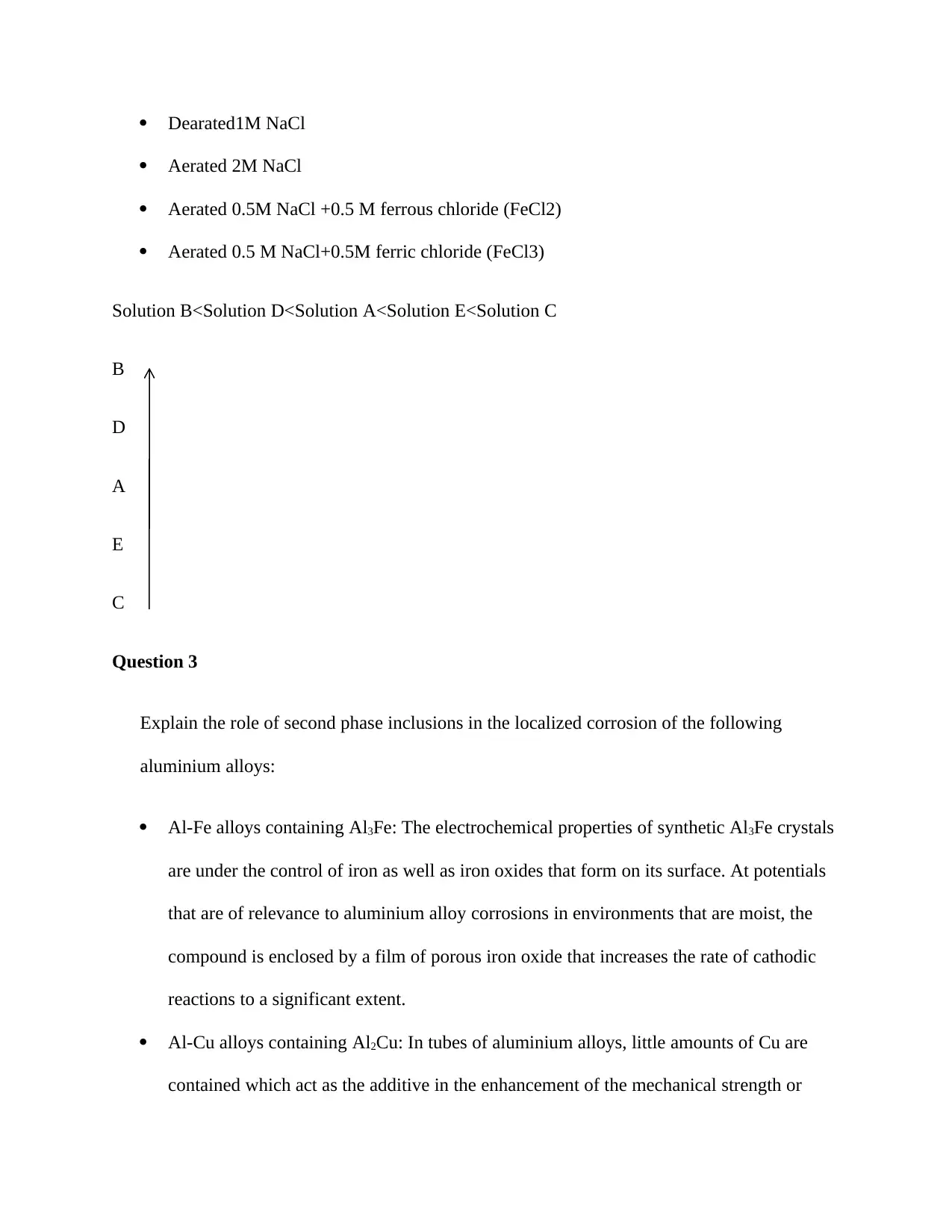
Dearated1M NaCl
Aerated 2M NaCl
Aerated 0.5M NaCl +0.5 M ferrous chloride (FeCl2)
Aerated 0.5 M NaCl+0.5M ferric chloride (FeCl3)
Solution B<Solution D<Solution A<Solution E<Solution C
B
D
A
E
C
Question 3
Explain the role of second phase inclusions in the localized corrosion of the following
aluminium alloys:
Al-Fe alloys containing Al3Fe: The electrochemical properties of synthetic Al3Fe crystals
are under the control of iron as well as iron oxides that form on its surface. At potentials
that are of relevance to aluminium alloy corrosions in environments that are moist, the
compound is enclosed by a film of porous iron oxide that increases the rate of cathodic
reactions to a significant extent.
Al-Cu alloys containing Al2Cu: In tubes of aluminium alloys, little amounts of Cu are
contained which act as the additive in the enhancement of the mechanical strength or
Aerated 2M NaCl
Aerated 0.5M NaCl +0.5 M ferrous chloride (FeCl2)
Aerated 0.5 M NaCl+0.5M ferric chloride (FeCl3)
Solution B<Solution D<Solution A<Solution E<Solution C
B
D
A
E
C
Question 3
Explain the role of second phase inclusions in the localized corrosion of the following
aluminium alloys:
Al-Fe alloys containing Al3Fe: The electrochemical properties of synthetic Al3Fe crystals
are under the control of iron as well as iron oxides that form on its surface. At potentials
that are of relevance to aluminium alloy corrosions in environments that are moist, the
compound is enclosed by a film of porous iron oxide that increases the rate of cathodic
reactions to a significant extent.
Al-Cu alloys containing Al2Cu: In tubes of aluminium alloys, little amounts of Cu are
contained which act as the additive in the enhancement of the mechanical strength or
Paraphrase This Document
Need a fresh take? Get an instant paraphrase of this document with our AI Paraphraser
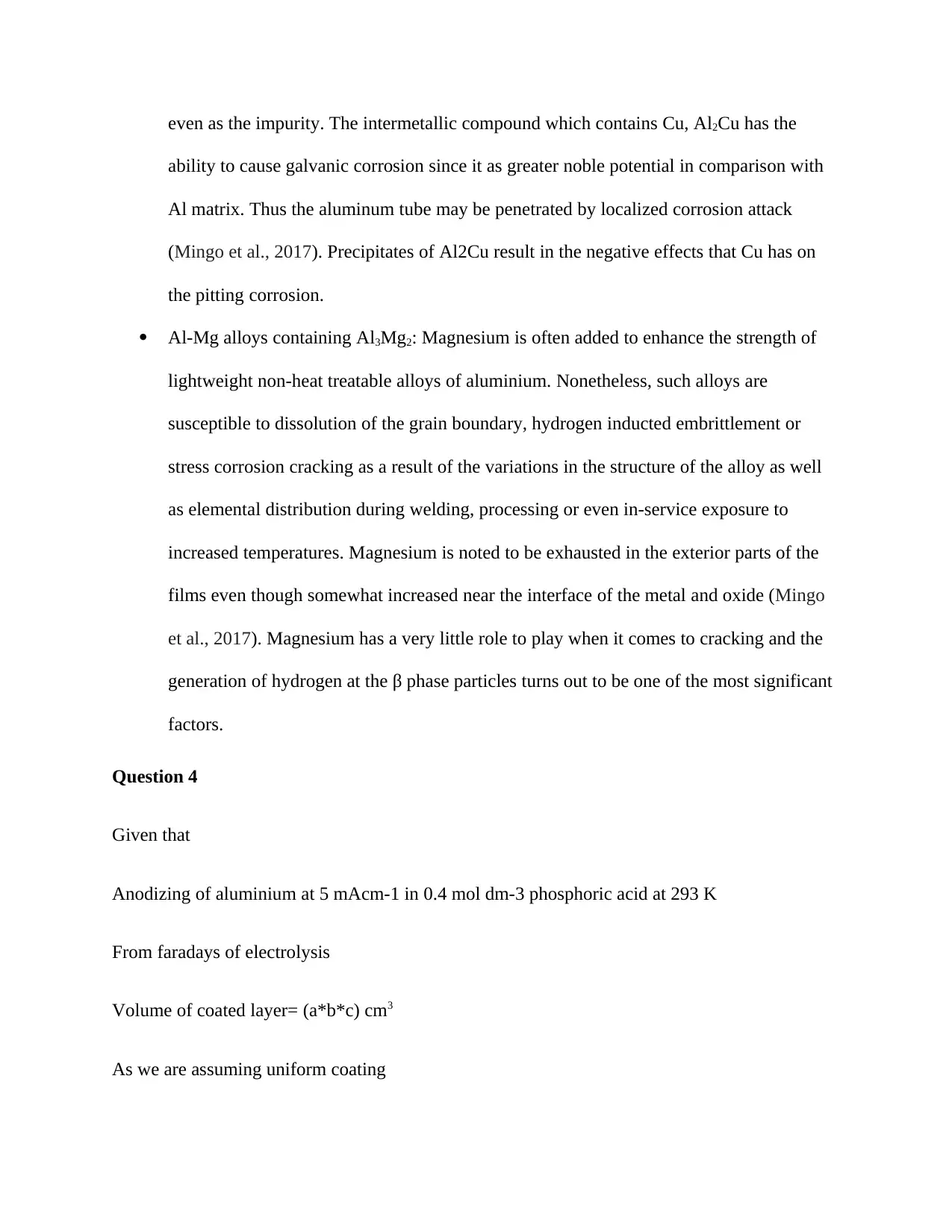
even as the impurity. The intermetallic compound which contains Cu, Al2Cu has the
ability to cause galvanic corrosion since it as greater noble potential in comparison with
Al matrix. Thus the aluminum tube may be penetrated by localized corrosion attack
(Mingo et al., 2017). Precipitates of Al2Cu result in the negative effects that Cu has on
the pitting corrosion.
Al-Mg alloys containing Al3Mg2: Magnesium is often added to enhance the strength of
lightweight non-heat treatable alloys of aluminium. Nonetheless, such alloys are
susceptible to dissolution of the grain boundary, hydrogen inducted embrittlement or
stress corrosion cracking as a result of the variations in the structure of the alloy as well
as elemental distribution during welding, processing or even in-service exposure to
increased temperatures. Magnesium is noted to be exhausted in the exterior parts of the
films even though somewhat increased near the interface of the metal and oxide (Mingo
et al., 2017). Magnesium has a very little role to play when it comes to cracking and the
generation of hydrogen at the β phase particles turns out to be one of the most significant
factors.
Question 4
Given that
Anodizing of aluminium at 5 mAcm-1 in 0.4 mol dm-3 phosphoric acid at 293 K
From faradays of electrolysis
Volume of coated layer= (a*b*c) cm3
As we are assuming uniform coating
ability to cause galvanic corrosion since it as greater noble potential in comparison with
Al matrix. Thus the aluminum tube may be penetrated by localized corrosion attack
(Mingo et al., 2017). Precipitates of Al2Cu result in the negative effects that Cu has on
the pitting corrosion.
Al-Mg alloys containing Al3Mg2: Magnesium is often added to enhance the strength of
lightweight non-heat treatable alloys of aluminium. Nonetheless, such alloys are
susceptible to dissolution of the grain boundary, hydrogen inducted embrittlement or
stress corrosion cracking as a result of the variations in the structure of the alloy as well
as elemental distribution during welding, processing or even in-service exposure to
increased temperatures. Magnesium is noted to be exhausted in the exterior parts of the
films even though somewhat increased near the interface of the metal and oxide (Mingo
et al., 2017). Magnesium has a very little role to play when it comes to cracking and the
generation of hydrogen at the β phase particles turns out to be one of the most significant
factors.
Question 4
Given that
Anodizing of aluminium at 5 mAcm-1 in 0.4 mol dm-3 phosphoric acid at 293 K
From faradays of electrolysis
Volume of coated layer= (a*b*c) cm3
As we are assuming uniform coating
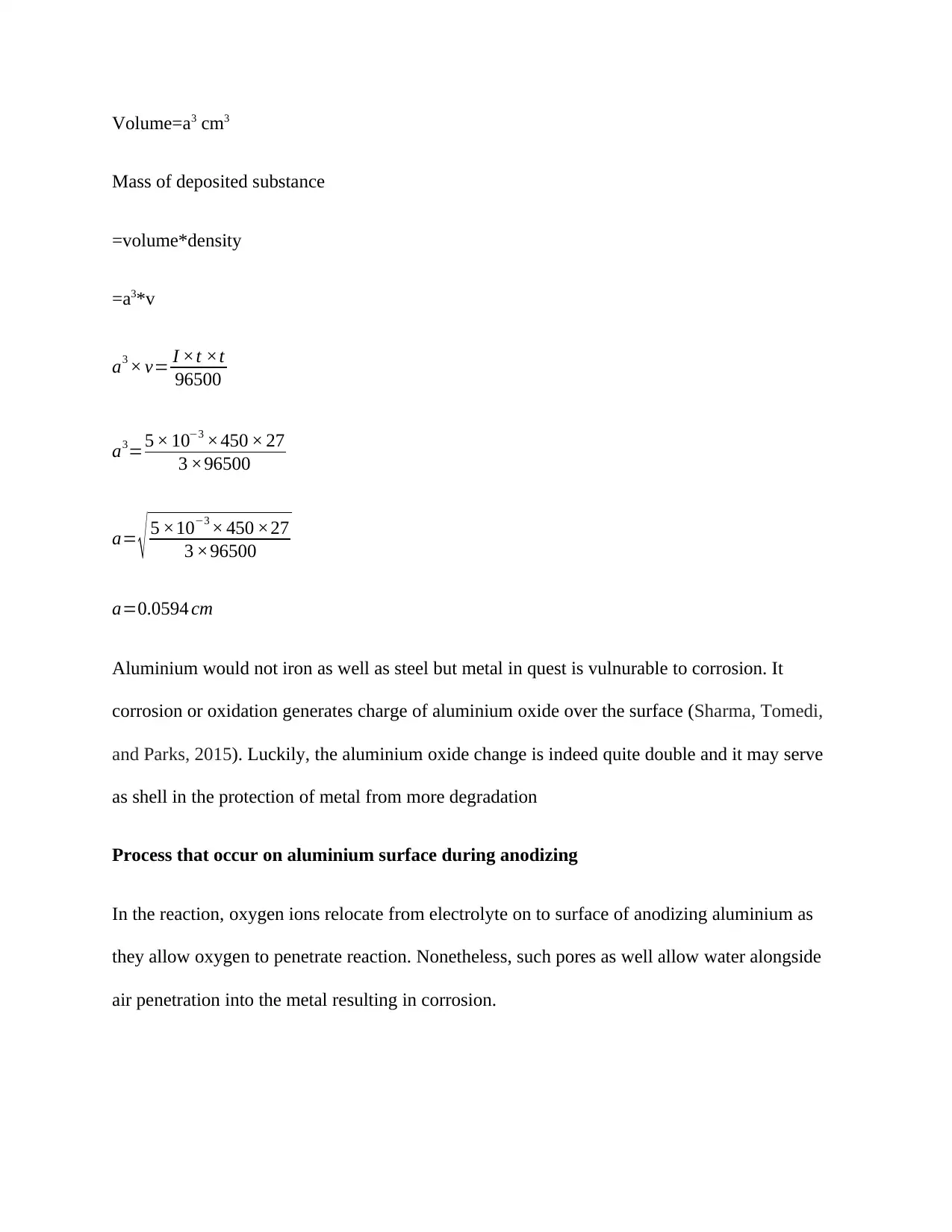
Volume=a3 cm3
Mass of deposited substance
=volume*density
=a3*v
a3 × v= I ×t ×t
96500
a3=5 × 10−3 ×450 × 27
3 ×96500
a= √ 5 ×10−3 × 450 ×27
3 ×96500
a=0.0594 cm
Aluminium would not iron as well as steel but metal in quest is vulnurable to corrosion. It
corrosion or oxidation generates charge of aluminium oxide over the surface (Sharma, Tomedi,
and Parks, 2015). Luckily, the aluminium oxide change is indeed quite double and it may serve
as shell in the protection of metal from more degradation
Process that occur on aluminium surface during anodizing
In the reaction, oxygen ions relocate from electrolyte on to surface of anodizing aluminium as
they allow oxygen to penetrate reaction. Nonetheless, such pores as well allow water alongside
air penetration into the metal resulting in corrosion.
Mass of deposited substance
=volume*density
=a3*v
a3 × v= I ×t ×t
96500
a3=5 × 10−3 ×450 × 27
3 ×96500
a= √ 5 ×10−3 × 450 ×27
3 ×96500
a=0.0594 cm
Aluminium would not iron as well as steel but metal in quest is vulnurable to corrosion. It
corrosion or oxidation generates charge of aluminium oxide over the surface (Sharma, Tomedi,
and Parks, 2015). Luckily, the aluminium oxide change is indeed quite double and it may serve
as shell in the protection of metal from more degradation
Process that occur on aluminium surface during anodizing
In the reaction, oxygen ions relocate from electrolyte on to surface of anodizing aluminium as
they allow oxygen to penetrate reaction. Nonetheless, such pores as well allow water alongside
air penetration into the metal resulting in corrosion.
⊘ This is a preview!⊘
Do you want full access?
Subscribe today to unlock all pages.

Trusted by 1+ million students worldwide
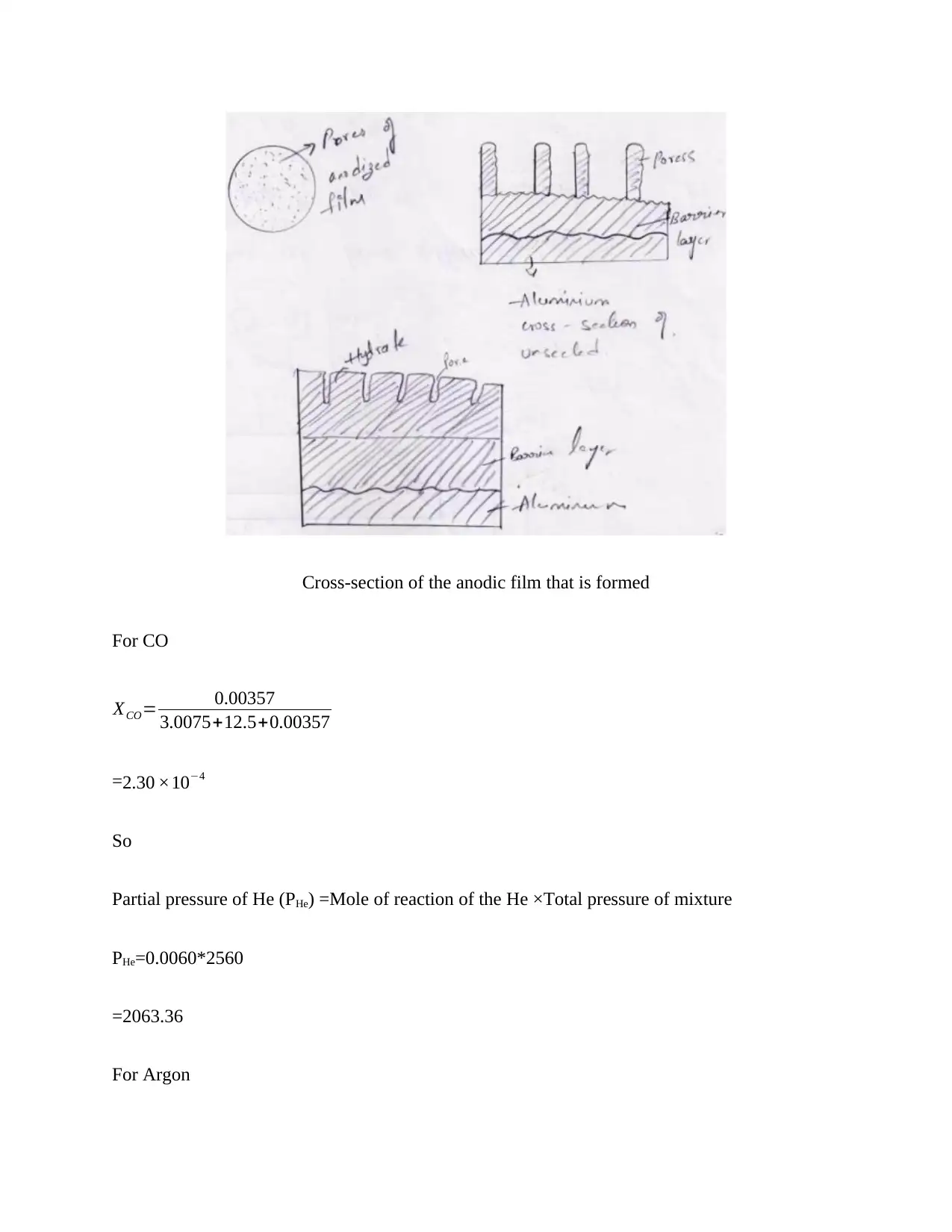
Cross-section of the anodic film that is formed
For CO
XCO= 0.00357
3.0075+12.5+0.00357
=2.30 ×10−4
So
Partial pressure of He (PHe) =Mole of reaction of the He ×Total pressure of mixture
PHe=0.0060*2560
=2063.36
For Argon
For CO
XCO= 0.00357
3.0075+12.5+0.00357
=2.30 ×10−4
So
Partial pressure of He (PHe) =Mole of reaction of the He ×Total pressure of mixture
PHe=0.0060*2560
=2063.36
For Argon
Paraphrase This Document
Need a fresh take? Get an instant paraphrase of this document with our AI Paraphraser
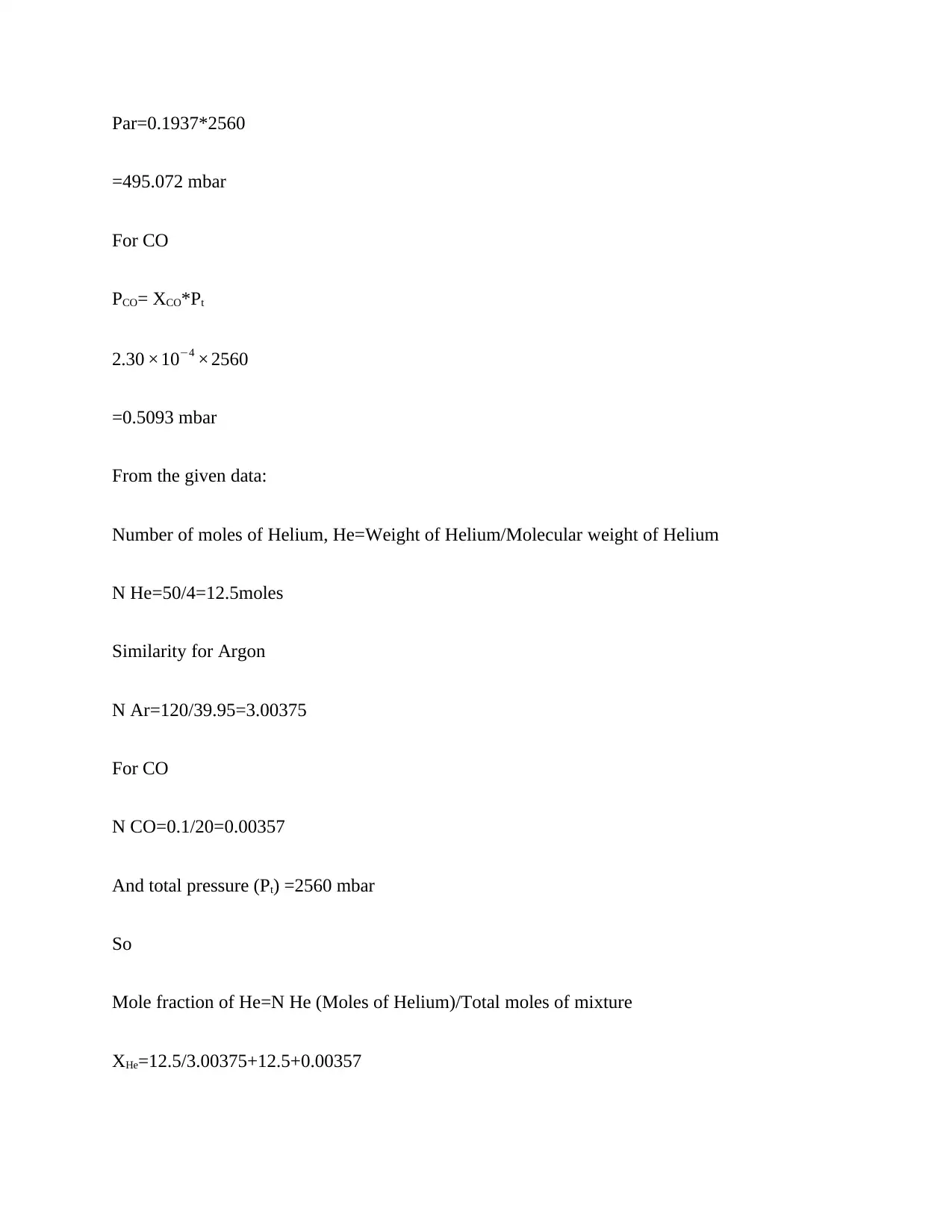
Par=0.1937*2560
=495.072 mbar
For CO
PCO= XCO*Pt
2.30 ×10−4 ×2560
=0.5093 mbar
From the given data:
Number of moles of Helium, He=Weight of Helium/Molecular weight of Helium
N He=50/4=12.5moles
Similarity for Argon
N Ar=120/39.95=3.00375
For CO
N CO=0.1/20=0.00357
And total pressure (Pt) =2560 mbar
So
Mole fraction of He=N He (Moles of Helium)/Total moles of mixture
XHe=12.5/3.00375+12.5+0.00357
=495.072 mbar
For CO
PCO= XCO*Pt
2.30 ×10−4 ×2560
=0.5093 mbar
From the given data:
Number of moles of Helium, He=Weight of Helium/Molecular weight of Helium
N He=50/4=12.5moles
Similarity for Argon
N Ar=120/39.95=3.00375
For CO
N CO=0.1/20=0.00357
And total pressure (Pt) =2560 mbar
So
Mole fraction of He=N He (Moles of Helium)/Total moles of mixture
XHe=12.5/3.00375+12.5+0.00357
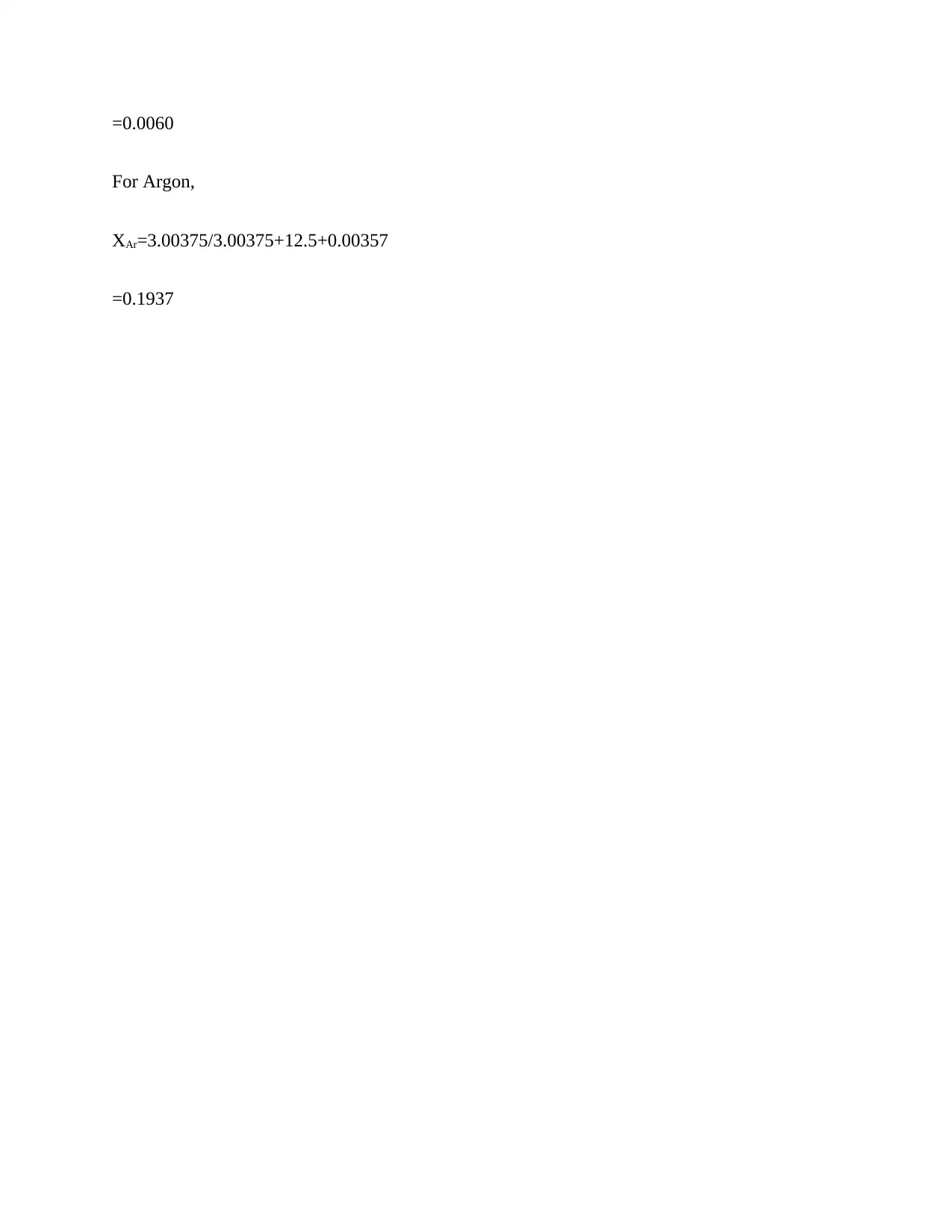
=0.0060
For Argon,
XAr=3.00375/3.00375+12.5+0.00357
=0.1937
For Argon,
XAr=3.00375/3.00375+12.5+0.00357
=0.1937
⊘ This is a preview!⊘
Do you want full access?
Subscribe today to unlock all pages.

Trusted by 1+ million students worldwide
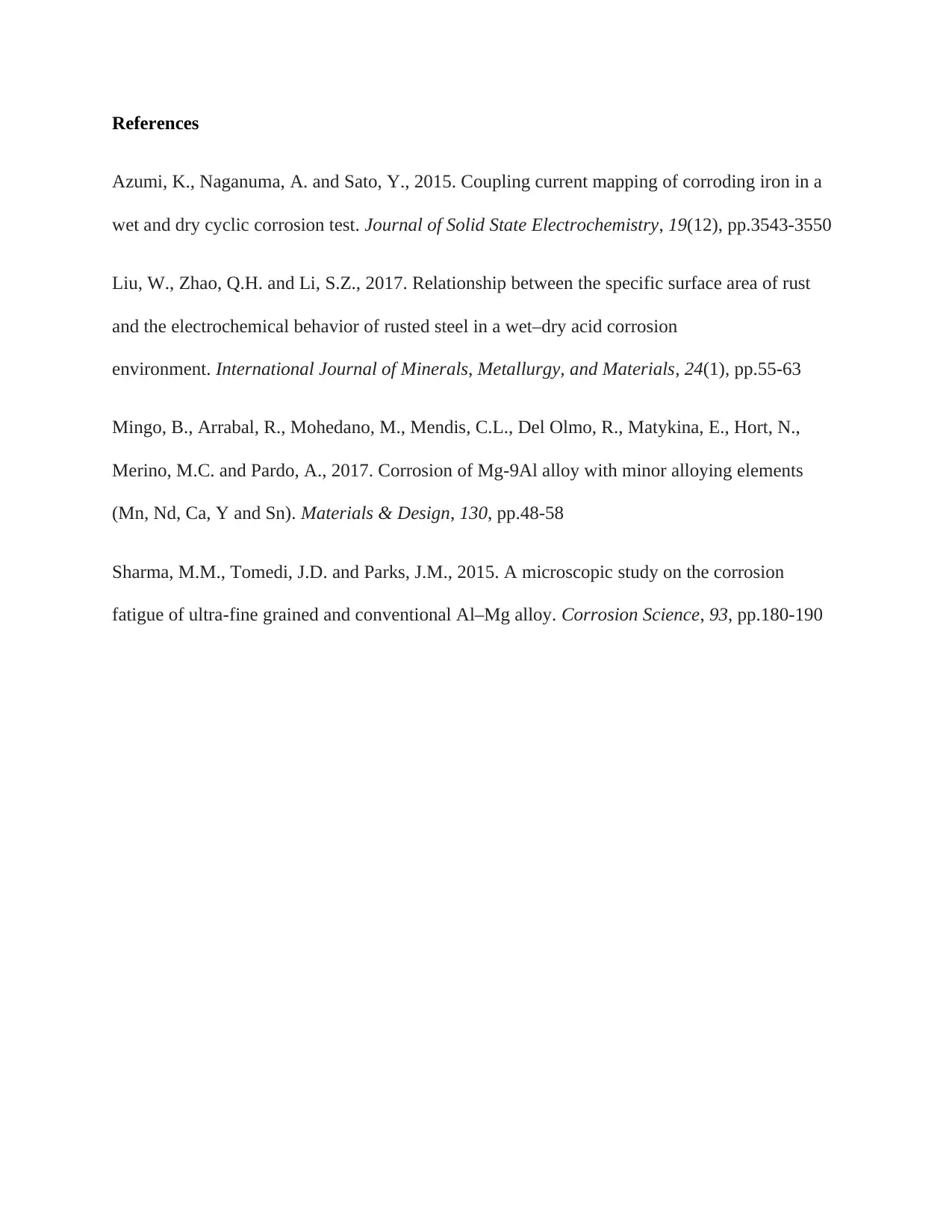
References
Azumi, K., Naganuma, A. and Sato, Y., 2015. Coupling current mapping of corroding iron in a
wet and dry cyclic corrosion test. Journal of Solid State Electrochemistry, 19(12), pp.3543-3550
Liu, W., Zhao, Q.H. and Li, S.Z., 2017. Relationship between the specific surface area of rust
and the electrochemical behavior of rusted steel in a wet–dry acid corrosion
environment. International Journal of Minerals, Metallurgy, and Materials, 24(1), pp.55-63
Mingo, B., Arrabal, R., Mohedano, M., Mendis, C.L., Del Olmo, R., Matykina, E., Hort, N.,
Merino, M.C. and Pardo, A., 2017. Corrosion of Mg-9Al alloy with minor alloying elements
(Mn, Nd, Ca, Y and Sn). Materials & Design, 130, pp.48-58
Sharma, M.M., Tomedi, J.D. and Parks, J.M., 2015. A microscopic study on the corrosion
fatigue of ultra-fine grained and conventional Al–Mg alloy. Corrosion Science, 93, pp.180-190
Azumi, K., Naganuma, A. and Sato, Y., 2015. Coupling current mapping of corroding iron in a
wet and dry cyclic corrosion test. Journal of Solid State Electrochemistry, 19(12), pp.3543-3550
Liu, W., Zhao, Q.H. and Li, S.Z., 2017. Relationship between the specific surface area of rust
and the electrochemical behavior of rusted steel in a wet–dry acid corrosion
environment. International Journal of Minerals, Metallurgy, and Materials, 24(1), pp.55-63
Mingo, B., Arrabal, R., Mohedano, M., Mendis, C.L., Del Olmo, R., Matykina, E., Hort, N.,
Merino, M.C. and Pardo, A., 2017. Corrosion of Mg-9Al alloy with minor alloying elements
(Mn, Nd, Ca, Y and Sn). Materials & Design, 130, pp.48-58
Sharma, M.M., Tomedi, J.D. and Parks, J.M., 2015. A microscopic study on the corrosion
fatigue of ultra-fine grained and conventional Al–Mg alloy. Corrosion Science, 93, pp.180-190
1 out of 10
Your All-in-One AI-Powered Toolkit for Academic Success.
+13062052269
info@desklib.com
Available 24*7 on WhatsApp / Email
![[object Object]](/_next/static/media/star-bottom.7253800d.svg)
Unlock your academic potential
Copyright © 2020–2025 A2Z Services. All Rights Reserved. Developed and managed by ZUCOL.
